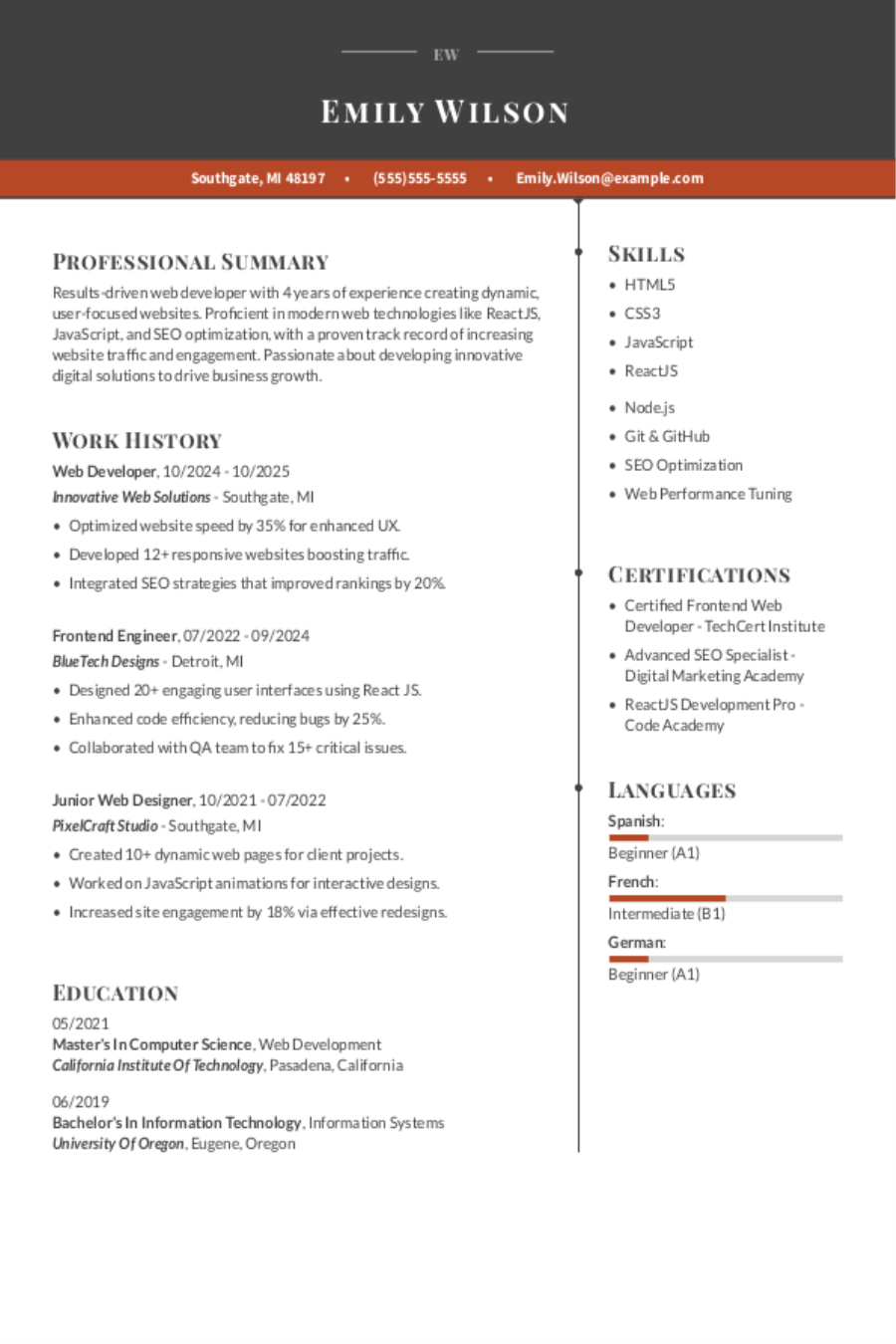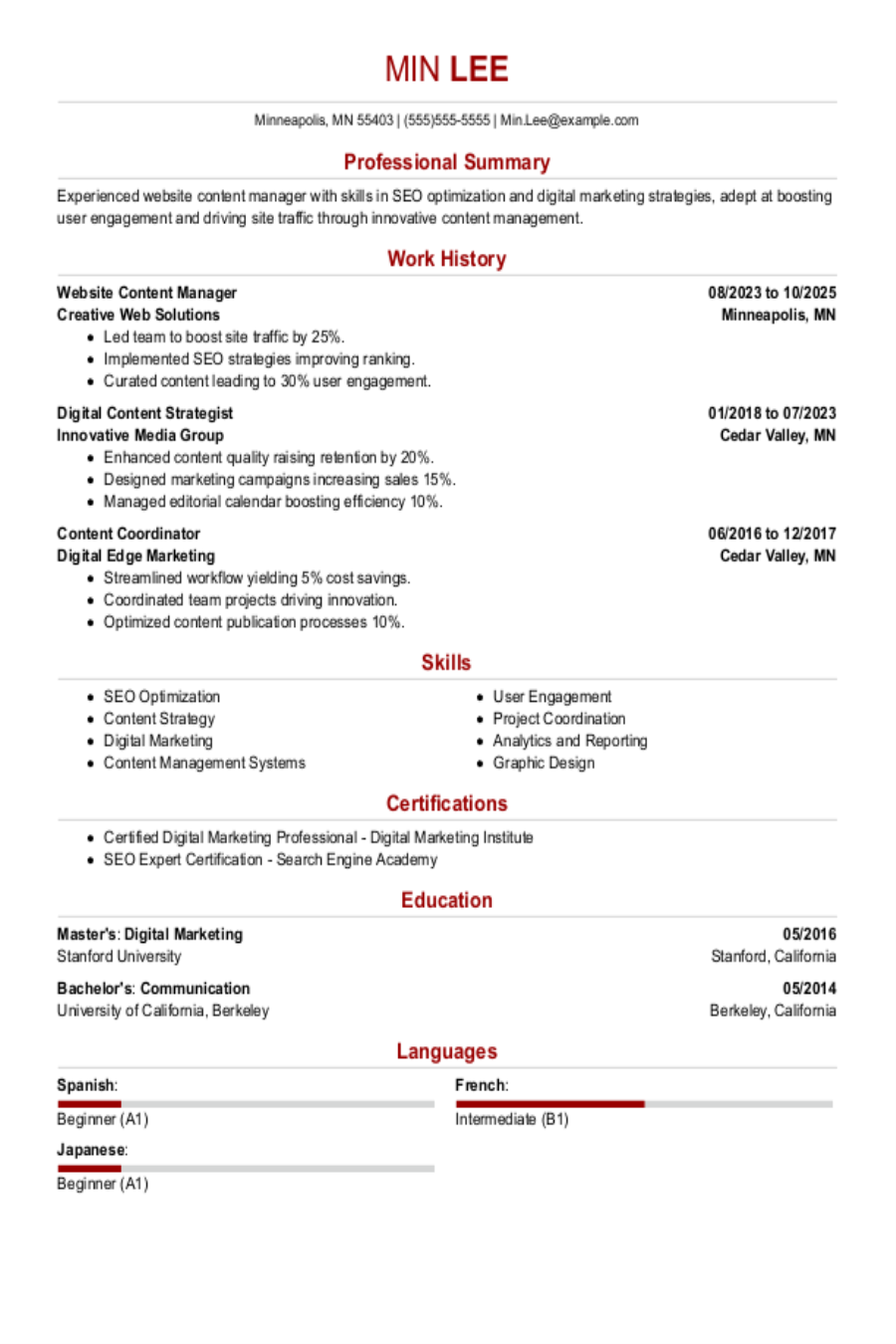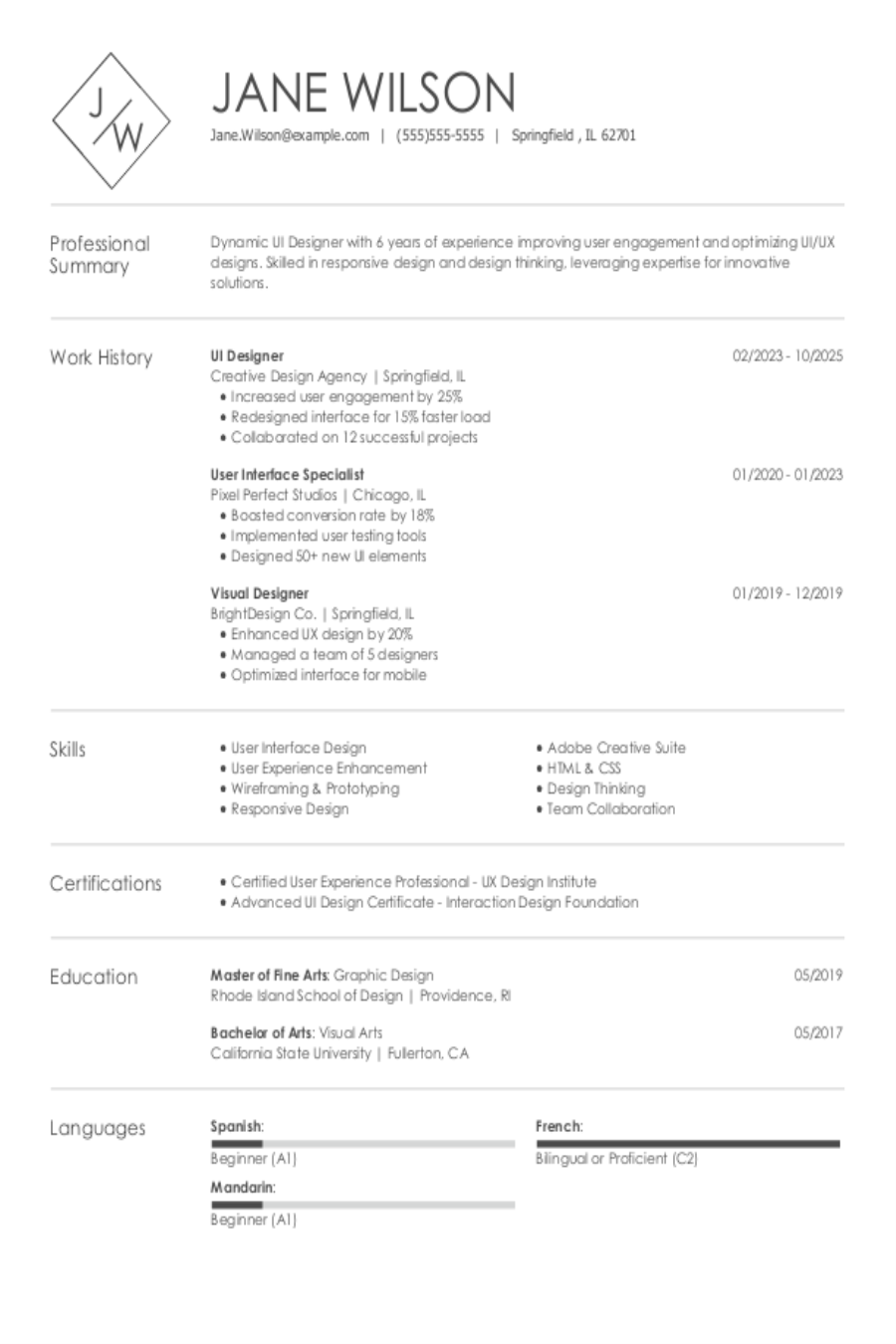Popular Personal Trainer Resume Examples
Entry-level personal trainer resume
An entry-level resume for a personal trainer should focus on relevant certifications, fitness-related coursework, practical experience, and interpersonal skills to demonstrate capability and enthusiasm for client success.
Emphasizes soft skills: Although the applicant has limited experience, this resume emphasizes their soft skills in motivational coaching, allowing them to showcase strengths despite being early in their career.
Prioritizes readability: A simple resume template effectively highlights this candidate's expertise in personal training, allowing recruiters to quickly spot their achievements and skills, such as motivational coaching and nutrition planning.
Mid-career personal trainer resume
A mid-career personal trainer resume should emphasize a combination of practical experience, certifications, and client success stories to demonstrate skill development and professional growth in fitness.
Encourages quick scanning: A well-structured resume allows employers to quickly identify key qualifications and achievements. Clear headings and bullet points improve readability, ensuring vital information stands out effortlessly.
Includes mix of skills: This resume effectively highlights a mix of technical expertise and interpersonal skills, showcasing the applicant's ability to develop tailored fitness programs while fostering strong client relationships.
Experienced personal trainer resume
An experienced personal trainer resume should emphasize certifications, client success stories, and the trainer's ability to develop customized fitness programs that demonstrate their professional growth.
Embraces modern design: This modern resume template showcases the job seeker's innovative approach, reflecting their dynamic and results-driven professional brand in the fitness industry.
Follows traditional format: The chronological resume format effectively showcases the job seeker's extensive experience, allowing them to present a clear timeline of roles and achievements that highlights their growth and expertise in personal training.
No experience personal trainer resume
A resume for an applicant with no experience should highlight relevant fitness certifications, personal training skills, and any volunteer work or internships that showcase an enthusiasm for health and wellness.
Overcomes lack of work history: Emphasizing professional skills highlights the applicant’s readiness for a personal trainer role, showcasing their dedication to health and wellness despite limited formal experience.
Leads with education: Prominently featuring the candidate's relevant degrees and including academic achievements in the accomplishments section helps this resume feel impactful.
More resume examples
Personal Trainer Resume Template
Kickstart your journey in fitness with this personal trainer resume template. Simply copy it and tailor the details to showcase your unique skills and experiences.
Chris Martinez
Lakeside, CA 92055
(555)555-5555
Chris.Martinez@example.com
Professional Summary
Dedicated personal trainer with 8 years' experience. Skilled in personalized fitness plans and group instruction. Proven track record in client retention and fitness goal achievements.
Work History
Personal Trainer
Peak Performance Fitness - Lakeside, CA
January 2022 - September 2025
- Increased client base by 30% within 12 months.
- Developed personalized fitness plans for 50+ clients.
- Led group training sessions with 20+ participants.
Fitness Instructor
Healthy Life Gym - Los Angeles, CA
January 2018 - December 2021
- Boosted class attendance by 25% annually.
- Created tailored workouts for diverse fitness levels.
- Trained new instructors, improving client retention by 15%.
Wellness Coach
FitBody Studio - Lakeside, CA
January 2015 - December 2017
- Increased membership sales by 20% through personalized programs.
- Conducted nutritional seminars attended by 100+ participants.
- Coached clients, achieving a 95% satisfaction rate.
Skills
- Personal Training
- Group Fitness Instruction
- Nutritional Guidance
- Client Retention
- Personalized Fitness Plans
- Strength Training
- Weight Management
- Motivational Coaching
Education
Master's Degree Exercise Science
University of California, Los Angeles Los Angeles, California
June 2014
Bachelor's Degree Kinesiology
San Diego State University San Diego, California
June 2012
Certifications
- Certified Personal Trainer - American College of Sports Medicine
- Group Fitness Instructor - American Council on Exercise
Languages
- Spanish - Beginner (A1)
- French - Beginner (A1)
- German - Intermediate (B1)
Must-Have Skills on a Personal Trainer Resume
A strong skills section is essential for demonstrating your qualifications as a personal trainer.
Wellness and beauty professionals help others feel their best, both inside and out. The skills you highlight should reflect your ability to create positive experiences, build trust, and tailor your approach to individual needs. You want your resume to show how you contribute to confidence, well-being, and lasting personal care.
The following data highlights key hard and soft skills commonly sought after in personal trainers based on insights from our extensive resume database.
When you're ready to improve your resume, explore the AI Resume Skills Generator. It offers tailored suggestions for both hard and soft skills that align with your job title, ensuring you present a comprehensive skill set.
Writing Your Personal Trainer Resume
Having explored these impressive personal trainer resume examples, you are now prepared to dive into the intricacies of how to write a resume. We'll guide you through each section step by step, ensuring you craft a standout application.
List your most relevant skills
A strong skills section on your personal trainer resume should highlight both hard skills, like knowledge of fitness programs and nutrition, and soft skills such as motivation and communication. This section helps align you with potential employers' expectations.
To improve your visibility, pay close attention to keywords from the job listing. Incorporating terms like "client assessment," "fitness goals," and "personalized training" signals to recruiters that you are a strong job seeker. This allows you to capture the attention of human recruiters and optimize your resume for applicant tracking systems, ensuring it reaches the right eyes.
Example of skills on a personal trainer resume
- Certified in developing personalized fitness plans tailored to individual goals
- Proficient in conducting fitness assessments and tracking client progress
- Motivational coach with a focus on building client confidence and accountability
- Strong communicator adept at fostering positive relationships with clients
A strong skills section is important for showing your readiness as a personal trainer. It should effectively combine the technical skills mentioned in the job description, such as knowledge of exercise techniques and fitness assessments, with essential soft skills like communication and motivation. This balance illustrates your comprehensive preparation to meet client needs and expectations.
Highlight your work history
Your work experience section should effectively highlight achievements and demonstrate how you’ve applied your fitness expertise to help clients reach their goals. Focus on showcasing measurable outcomes, like improved client performance or increased retention rates, as these will stand out to potential employers.
When detailing each job entry, be sure to include essential information such as your title, the name of the employer or gym, and the dates you were employed. This information not only establishes credibility but also helps employers gauge your level of experience in the industry.
Example of a personal trainer work experience entry
- Personal Trainer
Fitness First - Los Angeles, CA
June 2021 - Present - Develop personalized fitness programs for over 30 clients, focusing on individual goals and abilities to improve overall health and performance
- Conduct regular fitness assessments to track client progress, achieving a 90% retention rate through tailored adjustments and motivation strategies
- Lead group training sessions with an average attendance of 15 participants, fostering a supportive community atmosphere that promotes teamwork and accountability
- Educate clients on nutrition and lifestyle choices, resulting in an average weight loss of 10 pounds per client over three months
- Mentor junior trainers by sharing best practices in client engagement and program design, improving team effectiveness by 25%
Quantifying achievements as a personal trainer is essential to illustrate your impact on clients' progress. For example, stating that you helped clients lose an average of 15 pounds in three months can effectively highlight your ability to drive results and motivate individuals.
Include your education
The education section of your personal trainer resume should list your degrees and certifications in reverse-chronological order, starting with the most recent. Include relevant qualifications such as a degree in exercise science or certifications like Certified Personal Trainer from recognized organizations while omitting high school diplomas if you hold a higher level of education.
For those currently pursuing education or holding incomplete degrees, it is important to mention your highest completed level along with any expected graduation dates. Consider including some bullet points that highlight relevant coursework or academic achievements.
Common certifications for a personal trainer resume
- Certified Personal Trainer (CPT) – National Academy of Sports Medicine (NASM)
- Certified Strength and Conditioning Specialist (CSCS) – National Strength and Conditioning Association (NSCA)
- Personal Trainer Certification (PTC) – American Council on Exercise (ACE)
- Fitness Trainer Certification – International Sports Sciences Association (ISSA)
Sum up your resume with an introduction
Your resume should start with a profile that grabs attention and gives employers a clear snapshot of your qualifications. This section is important because it serves as your personal branding statement, showcasing your unique value and setting the tone for the rest of your application.
If you are an experienced applicant, consider using a professional summary to highlight your key achievements and relevant skills. If your professional experience is minimal, write a resume objective that shows your intent to grow and contribute.
Professional summary example
Dynamic personal trainer with over 5 years of experience in designing personalized fitness programs and guiding clients to achieve their health goals. Demonstrated success in improving client performance, increasing motivation, and fostering a supportive environment. Expert in nutrition counseling, strength training, and group fitness coaching.
Resume objective example
Enthusiastic personal trainer eager to apply a passion for fitness and strong communication skills to help clients achieve their health goals. Committed to leveraging knowledge in exercise science and nutrition to create tailored workout plans that inspire motivation and promote lasting lifestyle changes.
As a personal trainer, your resume profile is your initial opportunity to stand out. Focus on incorporating relevant keywords from job postings early in this section. This strategic approach not only highlights your qualifications but also improves your chances of passing through applicant tracking systems that employers commonly use to filter job seekers.
Add unique sections to set you apart
Incorporating optional resume sections can truly highlight your unique qualifications as a personal trainer. These sections allow you to stand out by showcasing aspects of your experience that may not fit neatly into traditional categories.
You have the opportunity to share relevant hobbies or volunteer experiences that align with your values and skills. For example, if you lead community fitness classes or participate in charity runs, these activities reflect your commitment to health and wellness. This insight not only enriches your resume but also gives potential employers a glimpse into your passion for fitness and community engagement, making you a more appealing job seeker.
Three sections perfect for a personal trainer resume
- Languages: As a personal trainer, effective communication is essential for motivating clients. Highlighting language skills on your resume can help you connect with diverse clients and improve their experience if you speak multiple languages.
- Volunteer Work: Including volunteer work on a resume showcases dedication and passion, improving your professional skills while highlighting your commitment to community service. It helps you stand out as a well-rounded job seeker.
- Accomplishments: As a personal trainer, quantifiable accomplishments validate your effectiveness and expertise. Emphasize these achievements within your work history or by making a dedicated accomplishments section.
5 Resume Formatting Tips
- Choose a format that matches your career stage.
Choosing the right resume format is important for showcasing your skills effectively. If you have ample experience, a chronological format highlights your career progression. For those just starting out, a functional format emphasizes skills over work history. Consider a combination format if you want to balance both aspects and present a comprehensive view of your qualifications.
- Pick a smart resume template.
Using a professional resume template can significantly improve the readability of your application. It allows hiring managers to quickly grasp your qualifications. Choose one that aligns with your style while ensuring it's simple and compatible with ATS systems for optimal formatting.
- Select an appropriate font.
Opt for a clear, professional font to improve resume readability. Fonts such as Helvetica, Georgia, or Verdana are excellent choices because they strike a balance between professionalism and ease of reading.
- Use consistent formatting.
Ensure your resume is formatted with left alignment and uniform margins to create a polished and professional look that stands out to potential employers.
- Keep your resume to one or two pages.
When crafting your resume, remember that resumes should be one page long unless you have extensive experience. Keep your content concise and focused to highlight the most relevant information about your skills and achievements.
Tools for Your Job Search
Are you eager to apply for that personal trainer position you've been eyeing? Before submitting your application, take advantage of our ATS Resume Checker. This essential tool provides insights into how well your resume meets the criteria set by automated systems that many fitness centers use during their initial screening process.
Looking to elevate your resume even further? Our AI Resume Builder offers tailored recommendations specifically designed for personal trainers, along with professional templates to help showcase your unique skills and certifications effectively.
Frequently Asked Questions
Last Updated: October 14, 2025
Absolutely. A cover letter is important because it adds depth to your resume and fosters communication with potential employers. It’s your opportunity to convey why you’re passionate about being a personal trainer and how your unique experiences make you the perfect fit for the role. Don’t hesitate—write a cover letter that showcases your enthusiasm and qualifications.
For a quick, effective solution, try our AI Cover Letter Generator. It allows you to create tailored cover letters in just minutes! Plus, you can choose from various cover letter template options that perfectly align with your resume, ensuring a professional and cohesive application package.
A resume is typically a concise document, spanning one to two pages, highlighting your skills and work experience. In contrast, a CV (curriculum vitae) can extend several pages, offering comprehensive details about your academic achievements, research contributions, and professional experiences.
You should use a CV when applying for specialized roles in academia, science, law, or medicine. If you're unsure whether to write a CV or resume for your job application, our online CV Maker is here to help! With various CV templates tailored for different industries and career levels, you can create an impressive CV quickly and efficiently.
To craft a standout personal trainer resume, select an eye-catching, professional template. Incorporate relevant keywords from the job description to demonstrate your alignment with the role and attract potential employers.
To ace your personal trainer interview, it's important to practice answering job interview questions and answers you might face. This preparation not only boosts your confidence but also equips you to handle any surprises that come your way during the conversation.
As a personal trainer, it’s beneficial to hint at your career aspirations in your resume summary. However, use your cover letter to elaborate on your goals, like obtaining certifications or specializing in a particular fitness area. Focus on applying for positions that foster growth and align with your long-term ambitions in health and wellness.
Embrace lifelong learning to stay ahead in the fitness industry. Pursue new certifications, attend workshops, and engage with professional networks. Regularly update your knowledge through fitness journals and online resources to improve your skills and credibility as a personal trainer.
Was this information helpful? Let us know!
Hailey is a career advice writer dedicated to helping job seekers excel in their careers.
More resources

Only 1 in 10 Resumes Include Measurable Results, New Analysis of 18.4M U.S. Resumes Finds
Resume Now takes a closer look at measurable results on resume...

Top Entry‑Level Careers That Are Fast‑Growing, Higher‑Paying, and AI‑Resistant
Artificial intelligence is touching more parts of work every y...

What Does It Mean if an Interviewer Says "Good Luck" or "We'll Be In Touch"?
Read on to learn the meaning behind these standard post-interv...

Web Developer Resume: Examples, Templates & Tips for 2025
Was this information helpful? Let us know ...



